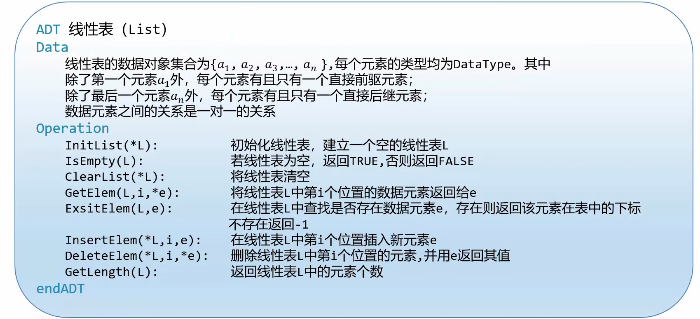认识线性表
定义
零个或多个数据元素的有限序列
特点
- 它是一个序列,数据之间是有序的,数据元素是一对一的关系。
- 线性表的数据元素个数是有限的。
常见操作
- 创建和初始化队列
- 查找
- 插入
- 删除
- 清空
线性表的抽象数据类型

线性表的顺序存储结构
定义
线性表的顺序存储结构,指的是用一段地址连续的存储单元依次存储线性表的数据元素。
优点
- 无须为表示表中元素之间的逻辑而增加额外的存储空间。
- 可以快速地存取任意位置的元素
缺点
- 插入删除操作需要移动大量的元素
- 当线性表长度变化较大时,难以确定元素存储空间的内容
- 造成空间的“碎片”
代码实现
// DataElement.h#ifndef INC_01_DATAELEMENT_H#define INC_01_DATAELEMENT_H#define MAX_SIZE 255// 定义数据元素typedef struct {int id;char * name;} ElementType;// 定义顺序表结构typedef struct {ElementType datas[MAX_SIZE]; // 顺序表中的数据集合int length; // 当前顺序表中的元素个数} SeqList;#endif
// SequenceList.h#ifndef INC_01_SEQUENCELIST_H#define INC_01_SEQUENCELIST_H#include <stdio.h>#include <stdlib.h>#include "DataElement.h"/*** 初始化顺序表* @param seqList 需要初始化的顺序表指针* @param elemArray 初始化时要添加的元素内容* @param length 初始化时添加的元素个数*/void InitList(SeqList * seqList, ElementType * elemArray, int length);/*** 向顺序表中插入某个元素* @param seqList 需要插入元素的顺序表指针* @param index 插入的位置* @param element 插入的元素*/void InsertElement(SeqList * seqList, int index, ElementType element);/*** 打印顺序表* @param seqList*/void PrintList(SeqList * seqList);/*** 在顺序表中删除某个元素* @param seqList 删除元素所在的顺序表指针* @param index 删除元素的下标* @return 返回删除的元素,如果删除失败返回 NULL*/ElementType * DeleteElement(SeqList * seqList, int index);/*** 在顺序表中查找某个元素* @param seqList 查找元素所在的顺序表指针* @param index 查找元素的下标* @return 返回查找元素的下标,如果查找失败返回 NULL*/ElementType * GetElement(SeqList * seqList, int index);/*** 返回顺序表的长度* @param seqList 返回总长度的顺序表指针* @return 返回顺序表长度*/int GetLength(SeqList * seqList);/*** 判断顺序表是否为空* @param seqList 判断是否为空的顺序表指针* @return 顺序表为空返回 1,否则返回 0*/int IsEmpty(SeqList * seqList);/*** 清空顺序表* @param seqList 要清空的顺序表指针*/void ClearList(SeqList * seqList);#endif
// SequenceList.c#include "SequenceList.h"/*** 初始化顺序表* @param seqList 需要初始化的顺序表* @param elemArray 初始化时要添加的元素内容* @param length 初始化时添加的元素个数*/void InitList(SeqList * seqList, ElementType * elemArray, int length) {if (length > MAX_SIZE) {printf("超出了数组的最大容量,初始化失败!\n");return;}seqList -> length = 0;for (int i = 0; i < length; i++) {InsertElement(seqList, i, elemArray[i]);}};/*** 向顺序表中插入某个元素* @param seqList 需要插入元素的顺序表* @param index 插入的位置* @param element 插入的元素*/void InsertElement(SeqList * seqList, int index, ElementType element) {if (seqList->length + 1 >= MAX_SIZE) {printf("数组已满, 插入元素失败!\n");return;}if (index < 0 || index > MAX_SIZE -1) {printf("只能在允许的下标范围内插入元素[0, %d]!\n", MAX_SIZE - 1);return;}if (index > seqList -> length) {printf("插入的下标超过了数组的最大长度-1,插入失败!\n");return;}for (int i = seqList -> length - 1; i >= index; i--) {seqList -> datas[i + 1] = seqList -> datas[i];}// 插入元素seqList -> datas[index] = element;// 顺序表的总长度 +1seqList -> length++;};/*** 打印顺序表* @param seqList*/void PrintList(SeqList * seqList) {for (int i = 0; i < seqList -> length; i++) {printf("%d\t%s\n", seqList -> datas[i].id, seqList -> datas[i].name);}};void PrintList(SeqList * seqList);/*** 在顺序表中删除某个元素 (使用完毕后必须 free!!!)* @param seqList 删除元素所在的顺序表* @param index 删除元素的下标* @return 返回删除的元素,如果删除失败返回 NULL*/ElementType * DeleteElement(SeqList * seqList, int index) {if (index < 0 || index > MAX_SIZE - 1) {printf("下标越界,无法删除!");return NULL;}// 保存已删除元素的副本ElementType * delElement = (ElementType*)malloc(sizeof(ElementType));*delElement = *GetElement(seqList, index);for (int i = index; i < seqList ->length - 1 ; ++i) {seqList -> datas[i] = seqList -> datas[i+1];}seqList -> length--;return delElement;};/*** 在顺序表中查找某个元素* @param seqList 查找元素所在的顺序表* @param index 查找元素的下标* @return 返回查找元素的下标,如果查找失败返回 NULL*/ElementType * GetElement(SeqList * seqList, int index) {if (index < 0 || index > MAX_SIZE) {printf("下标越界,无法找到指定元素!");return NULL;}ElementType * element; // 要查找的元素element = &seqList -> datas[index];return element;};/*** 返回顺序表的长度* @param seqList 返回总长度的顺序表指针* @return 返回顺序表长度*/int GetLength(SeqList * seqList) {if (seqList == NULL) {return 0;}return seqList ->length;};/*** 判断顺序表是否为空* @param seqList 判断是否为空的顺序表指针* @return 顺序表为空返回 1,否则返回 0*/int IsEmpty(SeqList * seqList) {return GetLength(seqList) == 0 ? 0 : 1;};/*** 清空顺序表* @param seqList 要清空的顺序表指针*/void ClearList(SeqList * seqList) {if (seqList == NULL) {return;}seqList->length = 0;};
// main.c
#include <stdio.h>
#include <stdlib.h>
#include "SequenceList.h"
ElementType dataArray[] = {
{1, "奇异博士"},
{2, "美国队长"},
{3, "太上老君"},
{4, "齐天大圣"},
};
void TestSequenceList();
int main() {
TestSequenceList();
return 0;
}
void TestSequenceList() {
SeqList seqList; // 要操作的顺序表
InitList(&seqList, dataArray, sizeof(dataArray) / sizeof(dataArray[0]));
PrintList(&seqList);
};

